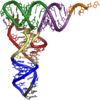Portal:Molecular and cellular biology
Portal:Molecular and cellular biology
Jump to navigation
Jump to search
Portal maintenance status: (June 2018)
Please take care when editing, especially if using automated editing software. |
Introduction
Molecular biology /məˈlɛkjʊlər/ is a branch of biology that concerns the molecular basis of biological activity between biomolecules in the various systems of a cell, including the interactions between DNA, RNA, proteins and their biosynthesis, as well as the regulation of these interactions. Writing in Nature in 1961, William Astbury described molecular biology as: Read more...
Cell biology (also called cytology, from the Greek κυτος, kytos, "vessel") is a branch of biology that studies the structure and function of the cell, which is the basic unit of life. Cell biology is concerned with the physiological properties, metabolic processes, signaling pathways, life cycle, chemical composition and interactions of the cell with their environment. This is done both on a microscopic and molecular level as it encompasses prokaryotic cells and eukaryotic cells. Knowing the components of cells and how cells work is fundamental to all biological sciences; it is also essential for research in bio-medical fields such as cancer, and other diseases. Research in cell biology is closely related to genetics, biochemistry, molecular biology, immunology and cytochemistry . Read more...
Selected article

Enzymes are proteins or RNA that catalyze (i.e. accelerate) chemical reactions. Enzymes are biochemical catalysts. In these reactions, the molecules at the beginning of the process are called substrates, and the enzyme converts these into different set of molecule(s), the product(s). Almost all processes in the cell need enzymes in order to occur at significant rates. Since enzymes are extremely selective for their substrates and speed up only a few reactions from among many possibilities, the set of enzymes made in a cell determines the biochemistry and signal transduction that occur in a cell.
Selected image

Overview of C4 carbon fixation, one of three biochemical mechanisms, along with C3 and CAM photosynthesis, functioning in land plants to "fix" carbon dioxide (binding the gaseous molecules to dissolved compounds inside the plant) for sugar production through photosynthesis.
Selected biography
Rosalind Elsie Franklin (25 July 1920 – 16 April 1958) was an English physical chemist and crystallographer who made important contributions to the understanding of the fine structures of DNA, viruses, coal and graphite. Franklin is best known for her contribution to the discovery of the structure of DNA in 1953. In the years following, she led pioneering work on the tobacco mosaic and polio viruses. She died in 1958 of ovarian cancer.
Did you know...
- ...that a Ribozyme is an RNA molecule that can catalyze a chemical reaction just like enzymes and may pre-date them?
- ...that several groups have managed to add non-natural bases to DNA, while others have added non-natural amino acids into the genetic code?
- ...that Deinococcus radiodurans is one of the most radioresistant organisms known, while some fungi survive by harnessing the energy from radiation?
- ...that the cytoskeleton of a cell acts like a tensegrity model [1], such that a cell can resist shear, compression and tension?
- ...that eggs laid by the Ostrich can weigh 1.3 kg and the contained yolk is the largest single cell of any organism?
- ...that Red blood cells have an average life span of 120 days?
- ...that Red blood cells do not contain the genetic material needed to synthesize new proteins or undergo cell division?
- ...that Robert Hooke coined the biological term cell -- so called because his observations of plant cells reminded him of monks' cells which were called "cellula"?
Molecular and cellular biology news
October 2009, Nobel foundation: The Nobel Prize in Physiology or Medicine 2009 went to Elizabeth H. Blackburn, Carol W. Greider and Jack W. Szostak for the discovery of how chromosomes are protected by telomeres and the enzyme telomerase.
More... molecular..., cellular...
archive
Things you can do
Here are some things you can do:
Expert attention needed: Molecular and Cell Biology articles
- Accuracy disputes:
Attention: Cell division, Cell membrane, G0 phase
Expand: Calcium signaling, Embryogenesis, Gamete, Hematopoesis, Lipid signaling
Merge: Germ layer
Cleanup: Cell, DNA
Requests: Chimeric DNA, protocadherin, RuBisCO activase, PEP carboxylase more...
Stubs: Molecular and cellular biology stubs; Biochemistry stubs; Cell biology stubs; Developmental biology stubs; Genetics stubs
- Peer review: Interphase
Genetic code The Molecular and Cellular Biology WikiProject's current Collaboration of the Month article is Genetic code. Please help to improve this article to featured article status. Last month's collaboration was Gene expression. |
Categories
Branches of Molecular and cellular biology
- Biochemistry
- Biotechnology
- Bioinformatics
- Cell Biology
- Developmental Biology
- Genetics
- Microbiology
Molecular Biology: Cell Signaling
- Systems Biology
WikiProjects
- WikiProject Molecular and Cell Biology
Daughter Projects
- WikiProject Cell Signaling
- Wikipedia:WikiProject Genetics
- Portal:Gene Wiki
Task forces
- Metabolic Pathways
Quotes
| “ | To doubt everything or to believe everything are two equally convenient solutions; both dispense with the necessity of reflection. | ” |
- —Jules Henri Poincaré, La Science et l'Hypothèse (Of Science and Hypotheses) (1901)
- —Jules Henri Poincaré, La Science et l'Hypothèse (Of Science and Hypotheses) (1901)
Molecular and cellular biology topics
 |  |  | |
Biotechnology | Cell biology | Developmental biology | Genetics |
|
|
|
|
 |  |  | |
Microbiology | Molecular biology | Biological techniques and tools | |
|
|
|
Related portals
 |  |  |  |  | |
Biology | Biotechnology | Chemistry | Medicine | Neuroscience | Science |
Associated Wikimedia
Categories:
- WikiProject Molecular and Cellular Biology articles
- Science portals
- Health science portals
(window.RLQ=window.RLQ||).push(function(){mw.config.set({"wgPageParseReport":{"limitreport":{"cputime":"0.248","walltime":"0.369","ppvisitednodes":{"value":1073,"limit":1000000},"ppgeneratednodes":{"value":0,"limit":1500000},"postexpandincludesize":{"value":82922,"limit":2097152},"templateargumentsize":{"value":1885,"limit":2097152},"expansiondepth":{"value":17,"limit":40},"expensivefunctioncount":{"value":1,"limit":500},"unstrip-depth":{"value":0,"limit":20},"unstrip-size":{"value":0,"limit":5000000},"entityaccesscount":{"value":0,"limit":400},"timingprofile":["100.00% 226.800 1 -total"," 23.55% 53.401 2 Template:Transclude_lead_excerpt"," 22.33% 50.639 13 Portal:Molecular_and_cellular_biology/box-header"," 21.25% 48.195 1 Template:Portal_maintenance_status"," 20.99% 47.610 13 Template:Box-header"," 13.04% 29.582 2 Template:Ombox"," 9.88% 22.413 1 Template:IPAc-en"," 8.70% 19.736 1 Template:Portal_description"," 8.07% 18.306 1 Template:Short_description"," 6.69% 15.178 1 Template:Pagetype"]},"scribunto":{"limitreport-timeusage":{"value":"0.084","limit":"10.000"},"limitreport-memusage":{"value":3099629,"limit":52428800}},"cachereport":{"origin":"mw1258","timestamp":"20181018013735","ttl":1900800,"transientcontent":false}}});mw.config.set({"wgBackendResponseTime":88,"wgHostname":"mw1262"});});

 Clash Royale CLAN TAG
Clash Royale CLAN TAG